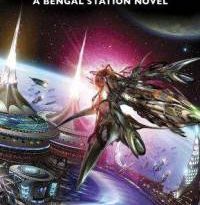Dislocations (The Kon-Tiki Quartet #1) by Eric Brown and Keith Brooke (book review).
Eric Brown has a history of writing tetralogies of linked Science Fiction novellas for PS Publishing with recent examples including the ‘Starship Seasons’ quartet (2007-2012) and the ‘Telemass Quartet’ (2014-2017). ‘Dislocations’ is the first volume in another such series, he Kon-Tiki Quartet’, first published in April 2018. This time, though, Brown has written it in collaboration with fellow British SF author Keith Brooke, whose 2012 novel ‘alt.human’ was shortlisted for the Philip K. Dick Award.
Before talking about the story, I will first tip my hat to Ben Baldwin, the cover artist, who has painted a beautiful wraparound cover showing the spacecraft after which the quartet is named, alongside some of the locations that are central to the story. One of the many things I love about PS Publishing is that their hardback novellas give you the cover art twice, once on the dust jacket, with the title and other lettering superimposed on top and a second time, on the cover of the book itself but this time without any lettering, so that you can admire the artwork in all its glory.
‘Dislocations’ is set in Earth’s medium-term future, when climate change and related environmental problems are truly starting to cause problems for mankind. While this has made many people focus their time and energy on saving the planet, the United Nations Space Agency has taken a different approach, building the ‘Kon-Tiki’, humanity’s first manned interstellar spacecraft, in Earth orbit. This is intended to spend a century taking a crew of eighteen scientists and engineers, along with five thousand colonists, all in suspended animation, to an exoplanet orbiting the star 19 Draconis some fifty light years from Earth. Assuming the exoplanet is habitable, humanity will then become a multi-planet species, reducing the risk of our extinction should the Earth not be salvageable for man.
The particular innovation for this mission is that the 18 expert crewmembers are not ordinary human beings but clones, whose minds will be uploaded to their bodies shortly before launch, while the original humans they are cloned from, whose combined expertise is deemed too valuable for Earth to lose, will remain back at home. One of those ‘originals’ is Dr. Travis Denholme, a British xeno-biologist who works out of the former RAF/American staffed base at Lakenheath in Suffolk, now converted into a spaceport.
When Travis’s colleague, the psychologist Kat Manning disappears unexpectedly, just days before the clones are due to be sent up to the ‘Kon-Tiki’, suspicion falls on the large group of environmental protestors surrounding the Lakenheath facility. Have they kidnapped her in the hope of stopping the launch? Disturbed by the low-key official response, Travis heads off base, hoping to find out what’s happened to his friend and stop her from becoming a casualty in the escalating conflict between two radically different visions for humanity’s future. Can he find and rescue Kat before the clones are due to launch?
One of the intriguing aspects of this book is that it is a tale about interstellar travel, yet none of the characters leave Earth until four pages before the end. The space mission is central to the storyline and the shuttle that will take the clones up to the orbiting starship ‘Kon-Tiki’ appears as a background object in several chapters. Nonetheless, there are no scenes in zero-gravity and no extended discussions of launch sequences, ascents to orbit or the lighting of fusion engines to send the ‘Kon-Tiki’ off towards the stars. Hard SF fans expecting such technical details may be disappointed by this but shouldn’t be surprised, given that Eric Brown is one of the co-authors. Brown is known for his character-based SF and in concert with Keith Brooke, that’s exactly what he delivers here.
The ‘will they/won’t they’ interplay between Travis and his would-be love interest Kat provides much of the sexual tension in the story, although several other characters at Lakenheath spaceport are romantically entangled, hinting at the closeted nature of their existence behind security barriers erected to keep the protestors out. What I found most interesting about these two characters, though, was their contrasting attitudes to their clones. Each will be staying behind on Earth while their apparently identical twins head off to another star. While Travis seems to have come to terms with his pedestrian fate, insisting that he is looking forward to returning to the study of biological problems at home, Kat seems completely unnerved by the existence of her clone, getting special permission to watch the moments when it is woken up and imprinted with her knowledge and memories. She insists that her interest is purely professional but it is clearly more profound than that. This exploration of contrasting responses to the idea of being superseded and, frankly, left in the shadows by your clone fascinated me. I hope the authors return to the theme later in the series.
Being a novella, the book has limited time and space to explore its secondary characters or introduce any complex sub-plots. Even so, the story felt fully three-dimensional to me, even if it was concentrated into a brief span and therefore focused on the central idea of Kat’s disappearance.
To conclude, Brown and Brooke have together crafted an exciting and enjoyable character-based SF tale, contained in an attractive and collectible hardback edition. I look forward to seeing what new direction they take in Part Two, ‘Parasites’.
Patrick Mahon
February 2019
(pub: PS Publishing, 108 page hardback novella. Price: £15.00 (UK). ISBN: 978-1-786363-14-5. E-book: Price: £ 3.99 (UK). ISBN: 978-1-786362-32-2)
check out websites: www.pspublishing.co.uk, www.ericbrown.co.uk and www.keithbrooke.co.uk






